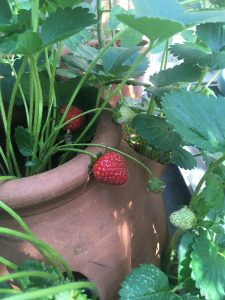It is not too late to use your greenhouse to force some early strawberries. There have of course been strawberries in the supermarkets all winter long, but these are grown in much warmer parts of the world, often with supplementary lights and heating, and then flown to us, coming with a huge carbon footprint and many air miles. Some of those that are starting to appear in grocer’s shops now have been forced the old-fashioned way. They are left in the ground through winter so that the plants receive the spell of cold they need to initiate flowering and fruiting, and are then lifted and brought under glass in late winter to flower and fruit there. Increasingly as the season goes on more of our strawberries will have been grown locally, as we see these fruits and those grown outdoors fruiting. We can use the shelter provided by our garden greenhouses in a similar way, to encourage fruits that are sweet and fat and deep red, and a little earlier than those facing this cold spring outdoors. It is a little late to go for really early ones, but bringing them in now will speed the process up and can help you to stagger fruiting times so that you don’t just end up with a couple of weeks of glut.

If you have any strawberries growing in pots the method is easy: you just move them indoors now. But if yours are growing in beds this is the time to dig some of them up and pot them up. You will want to select young plants, ideally a year or two old, for this, as they are vigorous and will produce better fruit. Early varieties are also best, and some old-fashioned varieties traditionally used for forcing include ‘Royal Sovereign’, ‘Gorella’ and ‘Cambridge Favourite’.
Once indoors they will want a deep drink, and a good feed of a high-potash fertiliser such as tomato fertiliser, which is particularly useful to any flowering or fruiting crops: it will keep the flowers coming. Also take care to keep these plants really well watered and regularly fed throughout the flowering and fruiting season, to help keep everything flowing. However always water in the morning or the middle of the day to allow the plants and ground around them to dry off before evening, otherwise moulds are encouraged. Once indoors, keep the greenhouse well ventiliated by opening vents and the door during hot days, as strawberries do not like to get too hot.
Pollination can be a problem under glass – flowers have to be pollinated in order to turn into fruits and there are few pollinators that will venture into the greenhouse and take their time leisurely flitting from plant to plant. You can end up with lovely healthy green plants and no strawberries. One way around this is to leave the plants in the ground uncovered until the flowers come out, are visited by pollinating insects, and then set – that is, they begin to grow into fruits – before you lift them and move them indoors under cover. They will still benefit from the warmth and you will still have slightly earlier strawberries, but you ensure good fruiting. Alternatively, you can take on pollination duties yourself, using a small soft paintbrush to mimic the action of the insects. Dab a flower with the soft dry brush and then move on to the next and so on, and you will transfer pollen from one to the other in just the same way insects do. Repeat this every few days until all of the fruits have set.










